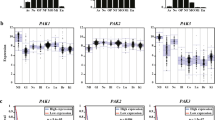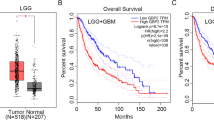Abstract
Gliomas are the most common type of malignant primary brain tumor in humans, accounting for 80 % of malignant cases. Expression and activity of Rho GTPases, which coordinate several cellular processes including cell-cycle progression and cell migration, are commonly altered in many types of primary brain tumor. Here we review the suggested effects of deregulated Rho GTPase signaling on brain tumor malignancy, highlighting the controversy in the field. For instance, whereas expression of RhoA and RhoB has been found to be significantly reduced in astrocytic tumors, other studies have reported Rho-dependent LPA-induced migration in glioma cells. Moreover, whereas the Rac1 expression level has been found to be reduced in astrocytic tumor, it was overexpressed and induced invasion in medulloblastoma tumors. In addition to the Rho GTPases themselves, several of their downstream effectors (including ROCK, mDia, and N-WASP) and upstream regulators (including GEFs, GAPs, PI3K, and PTEN) have also been implicated in primary brain tumors.
Similar content being viewed by others
References
American Cancer Society (2010) Cancer facts & figures 2010. http://www.cancer.org/acs/groups/content/@epidemiologysurveilance/documents/document/acspc-026238.pdf. Accessed 25 Nov 2010
Horner M et al (2009) SEER cancer statistics review, 1975–2006. http://seer.cancer.gov/csr/1975_2006/. Accessed 21 Jan 2011
Louis DN et al (2007) WHO classification of tumours of the central nervous system. WHO classification of tumours, vol 1, 4th edn. World Health Organization, IARC, Lyon
CBTRUS (2011) CBTRUS statistical report: primary brain and central nervous system tumors diagnosed in the United States in 2004–2007
DeAngelis LM (2001) Brain tumors. N Engl J Med 344(2):114–123
Takai Y, Sasaki T, Matozaki T (2001) Small GTP-binding proteins. Physiol Rev 81(1):153–208
Rojas AM et al (2012) Evolution: the Ras protein superfamily: evolutionary tree and role of conserved amino acids. J Cell Biol 196(2):189–201
Madaule P, Axel R (1985) A novel ras-related gene family. Cell 41(1):31–40
Ridley AJ (2012) Historical overview of Rho GTPases. Methods Mol Biol 827:3–12
Shinjo K et al (1990) Molecular cloning of the gene for the human placental GTP-binding protein Gp (G25K): identification of this GTP-binding protein as the human homolog of the yeast cell-division-cycle protein CDC42. Proc Natl Acad Sci USA 87(24):9853–9857
Ridley AJ et al (1992) The small GTP-binding protein rac regulates growth factor-induced membrane ruffling. Cell 70(3):401–410
Ridley AJ, Hall A (1992) The small GTP-binding protein rho regulates the assembly of focal adhesions and actin stress fibers in response to growth factors. Cell 70(3):389–399
Elias M, Klimes V (2012) Rho GTPases: deciphering the evolutionary history of a complex protein family. Methods Mol Biol 827:13–34
Boureux A et al (2007) Evolution of the Rho family of ras-like GTPases in eukaryotes. Mol Biol Evol 24(1):203–216
Guilluy C, Garcia-Mata R, Burridge K (2011) Rho protein crosstalk: another social network? Trends Cell Biol 21(12):718–726
Etienne-Manneville S, Hall A (2002) Rho GTPases in cell biology. Nature 420(6916):629–635
Bishop AL, Hall A (2000) Rho GTPases and their effector proteins. Biochem J 348(Pt 2):241–255
Machacek M et al (2009) Coordination of Rho GTPase activities during cell protrusion. Nature 461(7260):99–103
Gardiner EM et al (2002) Spatial and temporal analysis of Rac activation during live neutrophil chemotaxis. Curr Biol 12(23):2029–2034
Bourne HR, Sanders DA, McCormick F (1990) The GTPase superfamily: a conserved switch for diverse cell functions. Nature 348(6297):125–132
Hall A (1998) Rho GTPases and the actin cytoskeleton. Science 279(5350):509–514
Rosenblatt AE et al (2011) Inhibition of the Rho GTPase, Rac1, decreases estrogen receptor levels and is a novel therapeutic strategy in breast cancer. Endocr Relat Cancer 18(2):207–219
Bustelo XR, Sauzeau V, Berenjeno IM (2007) GTP-binding proteins of the Rho/Rac family: regulation, effectors and functions in vivo. BioEssays 29(4):356–370
Leung R, Glogauer M (2012) Rho GTPase techniques in osteoclastogenesis. Methods Mol Biol 827:167–179
Mulloy JC et al (2010) Rho GTPases in hematopoiesis and hemopathies. Blood 115(5):936–947
Wennerberg K, Der CJ (2004) Rho-family GTPases: it’s not only Rac and Rho (and I like it). J Cell Sci 117(Pt 8):1301–1312
Doye A, Mettouchi A, Lemichez E (2012) Assessing ubiquitylation of Rho GTPases in mammalian cells. Methods Mol Biol 827:77–86
Boulter E et al (2010) Regulation of Rho GTPase crosstalk, degradation and activity by RhoGDI1. Nat Cell Biol 12(5):477–483
Schmidt A, Hall A (2002) Guanine nucleotide exchange factors for Rho GTPases: turning on the switch. Genes Dev 16(13):1587–1609
Zheng Y et al (1996) The pleckstrin homology domain mediates transformation by oncogenic dbl through specific intracellular targeting. J Biol Chem 271(32):19017–19020
Bustelo XR (2000) Regulatory and signaling properties of the Vav family. Mol Cell Biol 20(5):1461–1477
Das B et al (2000) Control of intramolecular interactions between the pleckstrin homology and Dbl homology domains of Vav and Sos1 regulates Rac binding. J Biol Chem 275(20):15074–15081
Yohe ME et al (2007) Auto-inhibition of the Dbl family protein Tim by an N-terminal helical motif. J Biol Chem 282(18):13813–13823
Yohe ME, Rossman K, Sondek J (2008) Role of the C-terminal SH3 domain and N-terminal tyrosine phosphorylation in regulation of Tim and related Dbl-family proteins. Biochemistry 47(26):6827–6839
Aghazadeh B et al (2000) Structural basis for relief of autoinhibition of the Dbl homology domain of proto-oncogene Vav by tyrosine phosphorylation. Cell 102(5):625–633
Zamir E, Geiger B (2001) Molecular complexity and dynamics of cell-matrix adhesions. J Cell Sci 114(Pt 20):3583–3590
DeMali KA, Burridge K (2003) Coupling membrane protrusion and cell adhesion. J Cell Sci 116(Pt 12):2389–2397
Ren XD et al (2000) Focal adhesion kinase suppresses Rho activity to promote focal adhesion turnover. J Cell Sci 113(Pt 20):3673–3678
Tomar A et al (2009) A FAK–p120RasGAP–p190RhoGAP complex regulates polarity in migrating cells. J Cell Sci 122(Pt 11):1852–1862
Chrzanowska-Wodnicka M, Burridge K (1996) Rho-stimulated contractility drives the formation of stress fibers and focal adhesions. J Cell Biol 133(6):1403–1415
Kimura K et al (1996) Regulation of myosin phosphatase by Rho and Rho-associated kinase (Rho-kinase). Science 273(5272):245–248
Amano M, Nakayama M, Kaibuchi K (2010) Rho-kinase/ROCK: a key regulator of the cytoskeleton and cell polarity. Cytoskeleton (Hoboken) 67(9):545–554
Amano M et al (1997) Formation of actin stress fibers and focal adhesions enhanced by Rho-kinase. Science 275(5304):1308–1311
Watanabe N et al (1999) Cooperation between mDia1 and ROCK in Rho-induced actin reorganization. Nat Cell Biol 1(3):136–143
Mori K et al (2009) Rho-kinase contributes to sustained RhoA activation through phosphorylation of p190A RhoGAP. J Biol Chem 284(8):5067–5076
Burridge K, Wennerberg K (2004) Rho and Rac take center stage. Cell 116(2):167–179
Maekawa M et al (1999) Signaling from Rho to the actin cytoskeleton through protein kinases ROCK and LIM-kinase. Science 285(5429):895–898
Bernard O (2007) Lim kinases, regulators of actin dynamics. Int J Biochem Cell Biol 39(6):1071–1076
Takaishi K et al (1995) Translocation of activated Rho from the cytoplasm to membrane ruffling area, cell–cell adhesion sites and cleavage furrows. Oncogene 11(1):39–48
Antoine-Bertrand J et al (2011) The activation of ezrin–radixin–moesin proteins is regulated by netrin-1 through Src kinase and RhoA/Rho kinase activities and mediates netrin-1-induced axon outgrowth. Mol Biol Cell 22(19):3734–3746
Sanders LC et al (1999) Inhibition of myosin light chain kinase by p21-activated kinase. Science 283(5410):2083–2085
Edwards DC et al (1999) Activation of LIM-kinase by Pak1 couples Rac/Cdc42 GTPase signalling to actin cytoskeletal dynamics. Nat Cell Biol 1(5):253–259
Nutt CL et al (2003) Gene expression-based classification of malignant gliomas correlates better with survival than histological classification. Cancer Res 63(7):1602–1607
Forget MA et al (2002) The expression of rho proteins decreases with human brain tumor progression: potential tumor markers. Clin Exp Metastasis 19(1):9–15
Hwang SL et al (2005) Rac2 expression and mutation in human brain tumors. Acta Neurochir (Wien) 147(5): 551-554 (discussion 554)
Zavarella S et al (2009) Role of Rac1-regulated signaling in medulloblastoma invasion: laboratory investigation. J Neurosurg Pediatr 4(2):97–104
Senger DL et al (2002) Suppression of Rac activity induces apoptosis of human glioma cells but not normal human astrocytes. Cancer Res 62(7):2131–2140
Hwang SL et al (2004) Rac1 gene mutations in human brain tumours. Eur J Surg Oncol 30(1):68–72
Ding Q et al (2002) Promotion of malignant astrocytoma cell migration by osteopontin expressed in the normal brain: differences in integrin signaling during cell adhesion to osteopontin versus vitronectin. Cancer Res 62(18):5336–5343
Goldberg L, Kloog Y (2006) A Ras inhibitor tilts the balance between Rac and Rho and blocks phosphatidylinositol 3-kinase-dependent glioblastoma cell migration. Cancer Res 66(24):11709–11717
Manning TJ Jr, Parker JC, Sontheimer H (2000) Role of lysophosphatidic acid and rho in glioma cell motility. Cell Motil Cytoskelet 45(3):185–199
Malchinkhuu E et al (2009) Role of Rap1B and tumor suppressor PTEN in the negative regulation of lysophosphatidic acid-induced migration by isoproterenol in glioma cells. Mol Biol Cell 20(24):5156–5165
Yiin JJ et al (2009) Slit2 inhibits glioma cell invasion in the brain by suppression of Cdc42 activity. Neuro Oncol 11(6):779–789
Werbowetski-Ogilvie TE et al (2006) Inhibition of medulloblastoma cell invasion by Slit. Oncogene 25(37):5103–5112
Furukawa K et al (2006) PTEN gene transfer suppresses the invasive potential of human malignant gliomas by regulating cell invasion-related molecules. Int J Oncol 29(1):73–81
Malchinkhuu E et al (2005) Role of p38 mitogen-activated kinase and c-Jun terminal kinase in migration response to lysophosphatidic acid and sphingosine-1-phosphate in glioma cells. Oncogene 24(44):6676–6688
Rattan R et al (2006) Rho/ROCK pathway as a target of tumor therapy. J Neurosci Res 83(2):243–255
Deng L et al (2010) Rho-kinase inhibitor, fasudil, suppresses glioblastoma cell line progression in vitro and in vivo. Cancer Biol Ther 9(11):875–884
Nakabayashi H, Shimizu K (2011) HA1077, a Rho kinase inhibitor, suppresses glioma-induced angiogenesis by targeting the Rho-ROCK and the mitogen-activated protein kinase kinase/extracellular signal-regulated kinase (MEK/ERK) signal pathways. Cancer Sci 102(2):393–399
Oellers P et al (2009) ROCKs are expressed in brain tumors and are required for glioma-cell migration on myelinated axons. Glia 57(5):499–509
Lin CC et al (2009) Danthron inhibits the migration and invasion of human brain glioblastoma multiforme cells through the inhibition of mRNA expression of focal adhesion kinase, Rho kinases-1 and metalloproteinase-9. Oncol Rep 22(5):1033–1037
Salhia B et al (2005) Inhibition of Rho-kinase affects astrocytoma morphology, motility, and invasion through activation of Rac1. Cancer Res 65(19):8792–8800
Yamana N et al (2006) The Rho-mDia1 pathway regulates cell polarity and focal adhesion turnover in migrating cells through mobilizing Apc and c-Src. Mol Cell Biol 26(18):6844–6858
Belot N et al (2002) Extracellular S100A4 stimulates the migration rate of astrocytic tumor cells by modifying the organization of their actin cytoskeleton. Biochim Biophys Acta 1600(1–2):74–83
Yuan L et al (2010) ERK activation of p21 activated kinase-1 (Pak1) is critical for medulloblastoma cell migration. Clin Exp Metastasis 27(7):481–491
The Cancer Genome Atlas Research Network (2008) Comprehensive genomic characterization defines human glioblastoma genes and core pathways. Nature 455(7216):1061–1068
Guerreiro AS et al (2008) Targeting the PI3K p110alpha isoform inhibits medulloblastoma proliferation, chemoresistance, and migration. Clin Cancer Res 14(21):6761–6769
Witte HT et al (2009) Modeling glioma growth and invasion in Drosophila melanogaster. Neoplasia 11(9):882–888
Moon SY, Zang H, Zheng Y (2003) Characterization of a brain-specific Rho GTPase-activating protein, p200RhoGAP. J Biol Chem 278(6):4151–4159
McDonald KL et al (2007) IQGAP1 and IGFBP2: valuable biomarkers for determining prognosis in glioma patients. J Neuropathol Exp Neurol 66(5):405–417
Hu B et al (2009) ADP-ribosylation factor 6 regulates glioma cell invasion through the IQ-domain GTPase-activating protein 1-Rac1-mediated pathway. Cancer Res 69(3):794–801
Jarzynka MJ et al (2007) ELMO1 and Dock180, a bipartite Rac1 guanine nucleotide exchange factor, promote human glioma cell invasion. Cancer Res 67(15):7203–7211
Salhia B et al (2008) The guanine nucleotide exchange factors trio, Ect2, and Vav3 mediate the invasive behavior of glioblastoma. Am J Pathol 173(6):1828–1838
Acknowledgments
We would like to thank Dr Jonathan M. Backer for valuable intellectual input to the manuscript.
Conflict of interest
The authors declare they have no conflict of interest.
Author information
Authors and Affiliations
Corresponding author
Rights and permissions
About this article
Cite this article
Khalil, B.D., El-Sibai, M. Rho GTPases in primary brain tumor malignancy and invasion. J Neurooncol 108, 333–339 (2012). https://doi.org/10.1007/s11060-012-0866-8
Received:
Accepted:
Published:
Issue Date:
DOI: https://doi.org/10.1007/s11060-012-0866-8




